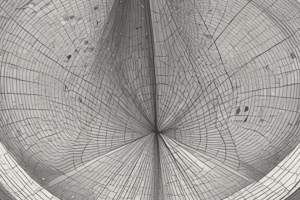Podcast
Questions and Answers
What defines a hyperbola in the context of navigation?
What defines a hyperbola in the context of navigation?
- The set of all points where the difference in distances to two fixed points is constant. (correct)
- A linear path defined by two intersecting lines.
- A curved line that intersects a plane at two points.
- The set of all points where the sum of the distances to two fixed points is constant.
Which component is crucial for generating hyperbolas in navigation systems like Loran-C?
Which component is crucial for generating hyperbolas in navigation systems like Loran-C?
- Synchronized radio signals. (correct)
- Pressure sensors.
- Visual landmarks.
- Magnetic compasses.
What is the main purpose of hyperbolic navigation systems?
What is the main purpose of hyperbolic navigation systems?
- To navigate using visual cues from landmarks.
- To measure atmospheric pressure changes.
- To find the position of a receiver based on signal timing. (correct)
- To determine the exact distance to celestial bodies.
How many pairs of ground stations are required to determine an exact position using hyperbolas?
How many pairs of ground stations are required to determine an exact position using hyperbolas?
What is one advantage of hyperbolic navigation systems?
What is one advantage of hyperbolic navigation systems?
Which of the following is a limitation of hyperbolic navigation systems?
Which of the following is a limitation of hyperbolic navigation systems?
What does dead reckoning primarily rely on for position estimation?
What does dead reckoning primarily rely on for position estimation?
In celestial navigation, what is primarily used to determine one’s position?
In celestial navigation, what is primarily used to determine one’s position?
What determines the accuracy of radar navigation?
What determines the accuracy of radar navigation?
Flashcards are hidden until you start studying
Study Notes
Navigational Equipment with Compasses
- Terrestrial navigation systems rely on various techniques to determine position fixes, including the use of hyperbolas.
Understanding the Hyperbola
- A hyperbola is a conic section derived from the intersection of a plane and a cone.
- Defined by two fixed points known as foci.
- The hyperbola consists of points where the difference in distances to the foci is constant.
- Key characteristics include two branches and a constant distance difference from any point on the curve to the foci.
Hyperbola in Position Fixing
- Hyperbolic navigation systems, such as Loran-C, leverage hyperbolas for precise location determination.
- Multiple ground stations emit synchronized radio signals, which are critical for position fixes.
- Time difference measurement between signals from two stations helps create a hyperbolic curve.
- At least two pairs of ground stations are necessary to derive the receiver's position, generating intersecting hyperbolas.
- The intersection points of multiple hyperbolas indicate possible locations for the receiver.
- Usage of additional methods, like a third hyperbola or dead reckoning, resolves potential ambiguities in positioning.
Visual Representation
- Diagrams illustrate the intersection of two hyperbolas, with connections to ground stations.
Advantages of Hyperbolic Navigation
- Hyperbolic navigation offers straightforward concepts and calculations.
- Effective for positioning over long distances, especially in coastal areas.
- Provides reasonable accuracy compared to other navigation systems.
Limitations of Hyperbolic Navigation
- Vulnerable to atmospheric conditions and signal interference.
- Necessitates multiple ground stations for functionality.
- Positional accuracy deteriorates as distance from ground stations increases.
Conclusion
- The hyperbola is integral to hyperbolic navigation systems, enabling position determination through time difference measurements and hyperbola intersection.
Position Fixing Techniques
- Dead Reckoning: Estimates current position based on known starting coordinates, speed, and direction; often combined with GPS for enhanced accuracy.
- Celestial Navigation: Utilizes celestial bodies’ positions (sun, moon, stars) for navigation, a technique still relevant today.
- Radar: Employs radio waves to detect and track objects, vital for determining the position of vessels or aircraft through time-of-flight measurements.
- Sonar: Utilizes sound waves for underwater detection and location, aiding in identifying submerged objects or terrain.
Studying That Suits You
Use AI to generate personalized quizzes and flashcards to suit your learning preferences.




